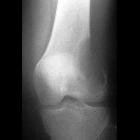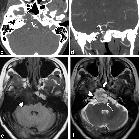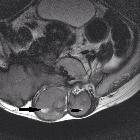sacral chordoma



This is an
MRI Image of Sacral Bone Chordoma in a man 35 years old. It penetrates sacral bone from back to the front. Other information No

Epidemiological
characteristics of 1385 primary sacral tumors in one institution in China. Location distribution of chordoma and giant cell tumor. a Chordomas at the Region S1 or S2 or S1-2 accounting for 1.6% (5/316); b Chordomas at the Region S3 or below S3 accounting for 45.9% (145/316); c Chordomas associated with both high and low levels accounting for 52.5% (166/316); d GCT at the Region S1 or S2 or S1-2 accounting for 39.0% (80/205); e GCT at the Region S3 or below S3 accounting for 5.4% (11/205); f GCT associated with both high and low levels accounting for 55.6% (114/205)

Chordoma •
Chordoma - sacrum - Ganzer Fall bei Radiopaedia

Chordoma •
Sacral chordoma - Ganzer Fall bei Radiopaedia

Chordoma •
Recurrent sacrococcygeal chordoma - Ganzer Fall bei Radiopaedia

Chordoma •
Sacral chordoma with metastases - Ganzer Fall bei Radiopaedia

Chordoma •
Sacrococcygeal chordoma - Ganzer Fall bei Radiopaedia

Chordoma •
Chordoma - Ganzer Fall bei Radiopaedia

Chordoma •
Sacrococcygeal chordoma - Ganzer Fall bei Radiopaedia

Chordoma •
Sacral chordoma - Ganzer Fall bei Radiopaedia

Bone up on
spinal osseous lesions: a case review series. Chordoma. Sagittal T2-weighted (a), axial T2-weighted fat-saturated (b), and coronal T2-weighted (c) images demonstrate a heterogeneously hyperintense, expansile and destructive lesion (orange arrows) involving the L3 vertebral body. Numerous internal septa (white arrows) are seen within the lesion, creating a “honeycomb” configuration. The lesion extrudes out and over the left aspect of the veretebral body (creating a "mushroom" appearance), and displaces the adjacent paraspinal musculature
 Assoziationen und Differentialdiagnosen zu sacrococcygeales Chordom:
Assoziationen und Differentialdiagnosen zu sacrococcygeales Chordom:










